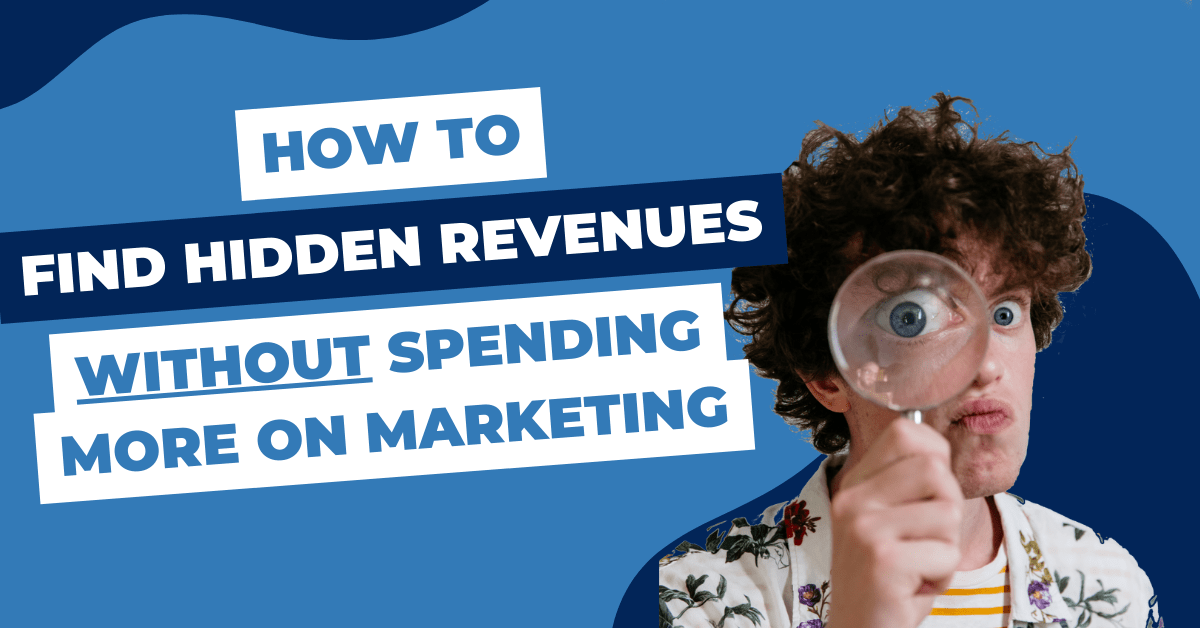How To FIND HIDDEN REVENUE Sources In Your Business Without Spending More On Marketing

How To FIND HIDDEN REVENUE Sources In Your Business Without Spending More On Marketing
How To FIND HIDDEN REVENUE Sources In Your Business Without Spending More On Marketing
A few years ago I was working with a technology venture firm that was left holding the bag by a potential buyer forcing them to pivot their new software product
They were looking for a way to bring in revenue for an unfinished software product without cash or a team—AND FAST.
So I turned to a lesson learned from one of my mentors: There are only three ways to grow a business.
More on that later…
Sometimes constraints are good. They simplify things.
Which led me to this constraint…
What if I had to increase revenue without spending more on marketing activities?
This is an exercise I’ve taken each of my clients through to identify an infinite number of ways to add new revenue—and it all relies on your strategic creativity. It also works in both B2B and B2C scenarios.
Here are the three steps to this process:
- Choose a revenue growth lever (Three ways to grow a business)
- Identify your best-selling product or service
- Add a revenue multiplier
Now let’s cover the three ways to grow a business below…
3 Steps To Hidden Revenue Sources
1. Choose a revenue growth lever (Three ways to grow a business)
The only way to grow a business is to increase: how much a customer will spend, the number of repeat purchases, and new customers. Let’s simplify this…
I call this the ABC Formula, increase:
- Average order value
- Buying frequency
- Customers
2. Identify your best-selling product or service
Once you’ve chosen your revenue growth lever. Your next step is to choose a product or service that will bring you the biggest revenue growth potential (most likely your best-seller).
3. Add a revenue multiplier
Here’s where it gets fun. Now that you’ve chosen a growth lever and identified a product, you’ll add a revenue multiplier.
Each growth lever has an infinite number of revenue multipliers. You’re only limited by your creativity (and execution).
For a service business:
Roofing Company
- Growth lever: Average Order Value
- Product: Residential roof repair
- Revenue multiplier: In order to increase average order value for their residential roof repair service, they can introduce an add-on.
Example: John the homeowner, needs his roof repaired. You quote him at $750 and offer him an add-on service, he takes your complete roof shingle preservation add-on package that will cost much less than a full replacement, but will add on an extra $2500, preserving his roof for more years to come. Now your $750 average order value has increased to $3250—a 3X increase per customer.
Web Design and Development Firm
- Growth lever: Buying Frequency
- Product: Custom website design
- Revenue multiplier: In order to increase buying frequency for their custom web design service, they can offer a continuity program.
Example: Mary owns a financial advisory firm and is in need of a new website. You quote her for a fully custom website at $8500 with additional services; a one and done sale. However, with a continuity program, you offer to do periodic maintenance and updates, as well as protect against cyber attacks for an additional $750/mo with a 1-year contract. Now you’ve created an additional 12 transactions per month for an extra $750 in monthly recurring revenue (or $9000/yr) from this one customer.
Cleaning Services
- Growth lever: Customers
- Product: Commercial cleaning services
- Revenue multiplier: In order to increase new customers, they can opt for partnerships.
Example: You’ve identified fitness centers as being one of your top ideal customer profiles (ICPs). To attract new fitness center clients, you opt for partnerships by joining organizations attended by successful owners. You quote them at $1000/mo for a 1-year contract and a % offer per location. For every signed referral they bring in you offer an additional % off. You’ve now got an incentivized referral model that expands with each new additional client.
For a physical product business:
Window and Door Retailer
- Growth lever: Average Order Value
- Product: Double-hung windows
- Revenue multiplier: In order to increase average order value for double-hung windows, they can offer an incentivized minimum order quantity (MOQ).
Example: Peter is replacing two out of eight windows in his new home at about $800/window for a total of $1600. To increase average order value you incentivize a minimum order quantity of a full 8-window replacement and offer a one-time % off the full $6400 + installation. You may even layer in financing to the deal.
Home Furniture and Decor Ecommerce
- Growth lever: Buying Frequency
- Product: Sofas
- Revenue multiplier: In order to increase buying frequency for sofas (one-time purchase), they can leverage communication around complementary products or services.
Example: Caroline just purchased a sofa from you, if your goal is to increase buying frequency, you leverage her contact information across multiple modalities (email, text, phone call, DMs, etc.) to draw attention to complementary products or services: non-slip furniture grippers, area rugs, non-slip rug mats, throw pillows, throw blankets, throw pillow covers, etc. Using a CRM you automate, personalize, and consistently communicate the value.
Printing, Signs, and Displays Company
- Growth lever: Customers
- Product: Commercial interior graphics
- Revenue multiplier: In order to increase new customers for commercial interior graphics, they can leverage acquisitions.
Example: For a printing company open to expansion, acquiring your competition is one of the fastest ways to revenue growth and new customers. Whether the owners are aging out, retiring, hit hard by the economy, or just looking to exit; this can open up an opportunity to acquire a competitor. If you just want the customer list, you can also sell off the assets and keep the customers.
What’s next
These are just a few examples of revenue multipliers…
Now that you have the exact framework I’ve given my clients to grow their revenue. Which of the three revenue growth levers offers the biggest opportunity in your business? Which product will you focus on first? What revenue multiplier provides the biggest up-side?
About the author
Steven Marin helps 7-figure owner-operators scale to 8-figures and beyond. He’s spent the last 10+ years working with service businesses, ecommerce, SaaS, and more. In his free time he enjoys traveling, trying different cuisines, and spending time with friends and family.
Want to find hidden revenue sources in your business? Apply now for a Hidden Revenue Workshop at no cost to you: https://sparkppc.com/contact/

